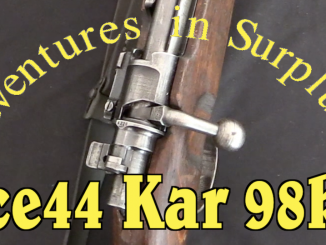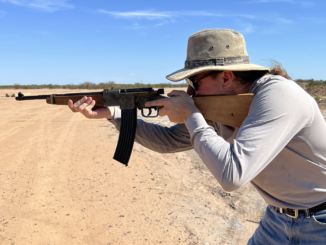The G33/40 carbine was made by the excellent Czech factory at Brno under German occupation (between 1940 and 1942). It was essentially a copy of the Czech vz.33 carbine, and was specifically issued to the Gebirgstruppen (mountain troops). It is easily distinguished from a typical Mauser by a couple characteristics: a shorter barrel (19.4″ compared to the K98k’s 24″) and a protective metal plate on the left side of the buttstock.
Related Articles

Bolt Action Rifles
Adventures in Surplus: Mid-war “CE44” German Kar 98k
Today’s rifle is a German Karabiner 98k, made by JP Sauer in 1944 and marked with the appropriate receiver code, “ce”. This is from the final year of JP Sauer production of the K98k, before […]

Bolt Action Rifles
VG45K: Rheinmetall’s 8mm Kurz Volksgewehr
As the end of World War Two loomed close, the German arms industry turned to a number of Volkssturm rifle designs. These were the crudest and simplest rifles that could be made to work with […]

Medium MGs
Japanese Type 97 Tank Machine Gun
While in Las Vegas last week, I stopped into Battlefield Vegas to check out some interesting machine guns (and join Tim from Military Arms Channel for a video). While there, the owner took the time […]

Excuse the pedantry, but in addition to the Heer’s Gebirgsjäger/ Mtn. troops, these carbines were also issued to the Luftwaffe’s Fallschirmjäger/ paratroops. Of course, given German practice, these were dropped in separate cannisters with other weapons larger than the MP38/40, pistol, and knife.
Nice bit of history laundry there. Brno had been known as Bruenn for 800 years, until 1919 when the new Czech government doubled the formal size of the city to eliminate the German majority and allow for the renaming as now “majority” Czech city.
Whiskey Tango Foxtrot? What possible relevance would the demographic and city limits history of Brno or Brünn or any other multi-ethnic Central or Eastern European city have to discussion of a Brno-made Mauser carbine? “History laundry?” Egads, man. Last time I checked my history books it was the Germans that annexed Czechoslovakia. Didn’t bode well for the ethnic Germans in the Sudeten or elsewhere when the whole ghastly Reich enterprise came crashing down…
I think it’s an interesting bit of historical trivia, even if it doesn’t have anything to do directly with this or any other weapon. It is relevant because a famous Czech arms factory was located there.
Perhaps 800 years is overdoing it a bit – Bohemia (Czechia) was an independent kingdom at least until 1620, the official language would be Czech and the names of the places as well.
Regards, Andrzej
Yeah, a little perspective. First, for a very long time both Moravia (where Brno is… in fact, it’s capital) and Bohemia were simply ruled by the Austro-Hungarians… and by the Hapsburgs before them. That a city had “been known as Bruenn for 800 years” is hardly surprising, given that the occupiers for the prior 800 years were, um, German-speaking; not too odd they’d have “know” it the German language spelling. (Seriously, no one but the Hungarians speak Hungarian…). As for the rest, there is very little controversy about the ethnicity of Moravia. And given that Brno is the capital of Moravia, one might want to look into things a bit before the rant over-takes.
Has anyone read stories or information on how the German troops felt about the very short barrel of the G33/40? In Finland the 514 mm (20.2″) barrel of the M38 and M44 Mosin-Nagant carbines was considered too short for regular infantry use, since it produced excessive muzzle flash.
According to John Walter in the various iterations of Guns of the Third Reich, the Gew.33/40 was heartily disliked by both Gebirgsjager and Fallschirmjager troops for its stupendous muzzle blast and flash, cannon-like report, and mule-kick recoil.
Firing it prone was reportedly sheer torture. It may not have broken any collarbones, but it certainly sprained more than a few shoulders.
It was one reason the paratroops asked for the FG-42. And why they were willing to put up with the extra weight (11 lbs empty) and drawbacks in handling (like “monopoding” on the magazine in prone firing) of the MkB-42/MP-43/StG-44 series.
At least those two confined themselves to doing damage to the intended target.
cheers
eon
Hmm… small rifle and big recoil=bad idea
Perhaps a muzzle brake should have been added…
“Hmm… small rifle and big recoil=bad idea”
All fire-arms have to comply with Newton’s rule: ACTION = REACTION, so it is always compromise, lighter weapon is easier to carry, when heavier is easier to fire.
I will bet that hardest hitting adopted by military is Swedish Gev m/40:
http://www.gotavapen.se/gota/artiklar/rifles_se/gev39_40.htm
it was chambered for 8×63mm patron m/32 which was cartridge designed for usage in machine gun (very potent cartridge, 218 gr @ 2500 fps, especially when compared to then default cartridge of Swedish Army – 6.5×55), it got muzzle brake after some broken collar bones reports, manual for that rifle noted that the soldier’s ears should be protected against the loud report, when practically no-one cares about that during WW2.
My understanding of the m/39 service rifle in Finland, limited by the language barrier and available English-language literature has it that the seeds of compromise between the Civil Guard and army lay in an army prototype, the m/35 that would have replaced the m/27 army and m/28 of the CG. It had a 20-in. barrel, and was roundly criticized for excessive muzzle blast and heavy recoil… So the civil guard sort of won out to a degree on the m/39 design acceptable to both defense institutions.
Yes, the Army wanted the M/91-35 to have a very short barrel and when that did not really turn out to be a good idea, they had to compromise more and adopt many of the Civil Guard’s ideas for the M/39. I don’t know if an intermediate length barrel was ever tried; the M/39 has a same length barrel as the M/28-30 (685 mm or 27″). Logically trying something like a 23″-24″ barrel would have made sense. It would have made the rather heavy M/39 somewhat lighter, but I suppose the very bad experiences with the M/91-35 discouraged further experimentation with shorter barrels.
Carbines are generally not intended for infantry use, but for auxiliary troops (artillery, cooks, cavalry,etc.).
The kick of 1944 is tremendous.
Regards, Andrzej
Agreed. I tried both the M38 and M44 Mosins and both kick like enraged mules! But then the same is true of many Mauser carbines. If my memory serves me well, the Persian M49 Mauser carbine in 8mm Mauser (derived from the Czech-made 98/29) is even shorter than the G33/40 and is noted for the incredible, flame fireballs it produces , artillery-like report, and vicious recoil… I am also thinking of very short Mauser carbines made by FN for the South American military and police markets in either 7×57 or 30-06 (the Colombian M 1950 carbine in 30-06 must be at the top in the rank of the worst recoil for a service bolt-action rifle in a ‘standard’ military round).
Cheers,
R. Aballe
Agreed. I tried both the M38 and M44 Mosins and both kick like enraged mules! But then the same is true of many Mauser carbines. If my memory serves me well, the Persian M49 Mauser carbine in 8mm Mauser (derived from the Czech-made 98/29) is even shorter than the G33/40 and noted for the incredible fireballs it produces, artillery-like report, and vicious recoil… I am also thinking of very short Mauser carbines made by FN for the South American military and police markets in either 7×57 or 30-06 (the Colombian M 1950 carbine in 30-06 must be at the top in the rank of the worst recoil for a service bolt-action rifle in a ‘standard’ military round).
Cheers,
R. Aballe
Did you notice that additional cuts were made in the rifle to further lighten it? The most obvious is the hole drilled in the underside of the bolt handle “knob”.
Are there books that warn you what to look out for in firearms manufactured in “annexed” Countries? It wasn’t all that pretty making things that your enemy might use to shoot your sister with…
so basically this is a Karabiner 98 kurz/kurz with a shortened short carbine barrel that is considered sniper rifle length today.
I love this gun. . . . .but a hell to shot with.Heavy recoil and big flash. By the way did you notice the caliber 7,88mm.
That’s not a “caliber” mark, it’s a bore diameter stamping. Going back to the 1880s, German military arms usually had their barrels stamped with the exact bore diameter of that particular example, as determined at the factory by the Army inspector with an inside micrometer.
You often see the same thing on M1879 and M1883 “Reichsrevolvers”, and P.08 Parabellum automatic pistols (Lugers).
A Reichsrevolver barrel marked “10.38mm”, “10.41mm”, or “10.4mm”, or a P.08 barrel marked “8.99mm”, “9.02mm”, or “9.00mm” just means that that particular barrel is just under, just over, or right at the specification.
The average allowable variance was generally about 0.03mm, over or under.
Since the spec on these was supposed to be exactly 7.9mm, one at 7.88mm would be “within spec”. One at 7.87mm would be borderline, and one at 7.86mm would likely be rejected.
DWM barrels ran from 7.9 to 7.92 on average, which may explain why people keep referring to the 7.9 x 57 round, and the rifles chambered for it, as a “7.92mm”. They were reading the bore spec stampings on barrels near the top of the acceptance range and assuming that they were caliber designations.
BTW, I used to own a Brno made Kar.98 that was stamped “7.89mm” in that spot.
cheers
eon
I wonder why this weapon was designated Gewehr, for rifle, when its barrel was about 4 inches shorter than the Kar98k, which was classed as a carbine? If the G33/40 is not a carbine, what is?
Secret German code to confuse die Allierten.
Dave:
Calling a carbine a rifle would not make Churchill lose much sleep, but it might annoy your own supply officers. Did they call boots helmets as well?
Nice video. Was hoping to see at least a field strip of the bolt (some of us can’t afford such a rifle) apparently there is a difference in bolt design (slight) to the k98 specifically the gas vent holes near the locking lugs. Anyway, keep up the awesome work!
The Czechs are regarded as “Germans” by other Slavs. I don’t speak any Slavic languages, but I can distinguish Czech by the German sounds. The Y chromosomes of the Czechs are very similar to the Germans in next door Sachsen . The rocky relationship between the Czechs and the Germans next door is a tragedy, but it caused my people to eventually end up here in the South (Thank God).
I prefer and love my modern “Czech Mauser carbine “, my CZ 527 7.62×39 carbine. It’s made by Czechs in Brno, based on a German rifle (Mauser), and it fires a Russian round (7.62×39). That’s pure Slavo-Germanic fusion.